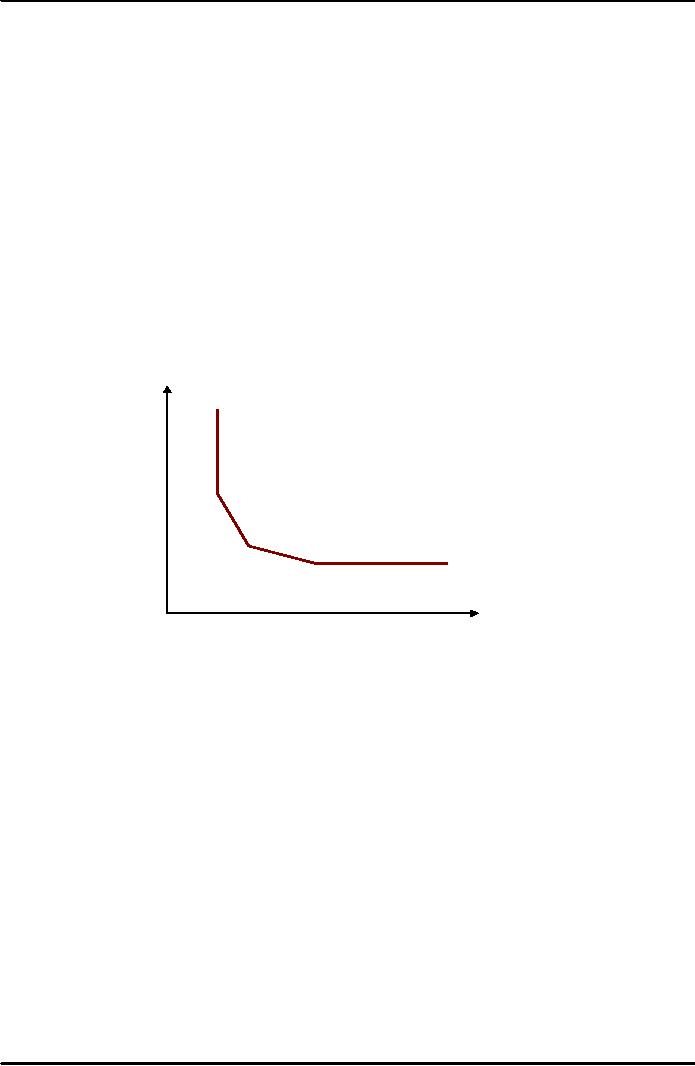 |
PROBLEMS OF LOWER INCOME COUNTRIES:Poverty trap theories: |
| << AN INTRODUCTION TO INTERNATIONAL TRADE AND FINANCE |

Introduction
to Economics ECO401
VU
UNIT
- 16
Lesson
16.1
PROBLEMS OF
LOWER INCOME
COUNTRIES
There
are huge income and
wealth disparities in the
world we live in. Roughly
one-fourth of the
world's
population accounts for on
three-fourths of the world's
resources and
consumption.
The
per capita income in the
world's poorest countries is
$330 per year whereas in
the richer
countries,
is $24,000 a year about 70
times higher!
More
worryingly, contrary to expectations
and wishes, these
disparities have not gone
away
since
the 1950s the time
when many of the world's
poorest countries (colonies)
got
independence.
In some cases (e.g. Africa),
disparities appear to have
actually increased,
widening
the living standards gap
between the first and
third worlds. Many people in
the Third
World
live in extreme poverty
beyond the wildest
imagination of the people
living in HICs.
Theories
about the Problems of
LICs:
In
order to explain this huge
problem of poverty and of
the asymmetric ownership of
wealth
and
income in the world,
economists have come up with
many theories.
Poverty
trap theories:
Poverty
trap theories explained the
relative poverty of the
Third World in the context
of the twin
gaps:
foreign exchange gap
(exports being less than
required imports) and an
underlying
savings
gap (domestic savings being
less than required
investment).11 As a result, the
LICs'
economies
were caught in the vicious
cycle of low saving, low
scale of investment,
low
productivity
gains (due to the absence of
scale economies), low per
capita growth
(remember
productivity
and technological progress
were the engines of PCI
growth), low savings
.......
The
Prebisch-Singer Hypothesis
(PSH):
A
rival theory was the
Prebisch-Singer Hypothesis (PSH),
which located the reasons
for this
persistent
poverty in the structure of
trade between the rich
and poor countries. The
PSH
maintained
that that LICs were
stuck in the production of
primary products (as
prescribed by
static
comparative advantage theories
like Hechscher-Ohlin prescribed)
which were subject to
both
volatility and declining
prices relative to manufactures
and capital goods.12
Some
economists pointed out the
lack of
human, social and public
capital in LICs as
the
single
most important factor
distinguishing them from,
say, post-WW2 Germany and
Japan,
countries
which were able to rebuild
themselves from total
destruction to great
economic
prosperity
on the back of a strong and
skilled workforce (human
capital), well-developed
institutions
like trust, meritocracy and
accountability (social capital),
and elaborate
communications,
energy and housing
infrastructures (public
capital).
Others
drew attention to the
very
fast rising populations in
LICs, and
the particular social
and
economic pressures created
thereby. Coupled also with
disease and severe ethnic
and
regional
conflicts, some saw the
situation in LICs as virtually
ungovernable.
Lack
of precious natural resources
(like oil, gold, gas,
iron, copper etc.) was
also cited by
some
as the reason for LICs'
continued poverty, and
examples were given of South
Africa and
the
OPEC countries, many of whom
were able to raise living
standards solely on the back
of
natural
resource exports. Strong
counter-argument exist against
this theory, for e.g.,
the LICs
which
registered the highest rates
of industrialization and GDP
growth during the last
four
decades,
namely: Korea, Taiwan, Hong
Kong, Singapore, did not
possess any
significant
natural
resources. The same is true
for Japan in the 20th century and the
European countries
in
the 18th and 19th
centuries.
11
Recall
from the discussion under
BOPs that M-X = I-S + G-T,
and thus, for a given
G-T, I-S and M-X go
hand
in
hand.
12
Refer
also to the micro lectures
on elasticity where the BOPs
problems of LICs are
explained in the context
of
income
price and substitution
elasticity's.
168

Introduction
to Economics ECO401
VU
Development
Strategies:
Keeping
the reasons for persistent
poverty in LICs aside, there
are three broad
development
strategies
that have been adopted to
address the
situation.
I.
DEVELOPMENT THROUGH
TRADE
Up
till the 1970s, it was
thought that LICs needed to
develop their import
competing industries
(import-substituting
industrialization), reduce their
dependence on consumer goods
imports by
switching
to domestically produced goods,
and hence gradually attain
self-sufficiency and
foreign
exchange adequacy. Inspired by
dynamic comparative advantage
theories and the
massive
Soviet industrialization drive
launched under Stalin, this
model was
passionately
followed
by many South Asian, African
and Latin American
countries. The results were
not
very
positive, unfortunately. For
one, the nationalization
policies that often
accompanied the
pursuit
of the ISI model led to a
crowding out of private
entrepreneurship (and with
it, the spirit
of
competition), and the birth
of highly inefficient public
enterprises, which later
became a
breeding
ground for corruption,
nepotism and labour dumping
(excess hiring). Second,
the
huge
savings expected on imports
never quite materialized.
Given the large current
account
deficits
delivered by weak exports
and stubbornly high imports,
therefore, many of
these
countries
went into BOPs crises
after the 1970s.
The
East Asian Model:
A
rival trade model which
proved very successful was
the East Asian one.
These countries
(Korea,
Indonesia, Taiwan, Hong
Kong, Singapore, Malaysia,
and to a lesser extent
Thailand,
Indonesia
and The Philippines)
industrialized not to produce
for the local markets
(i.e. to
substitute
their imports) but to
produce for the
international market (competing
with foreign
producers).
As a result they had a
focus, from the very
start, on productive efficiency
and did
not
rely on high tariff
protection for very long
and therefore attained a
sustainable ascent on
the
comparative advantage ladder
(from primary products to
high tech goods). These
are the
countries
which have been the
fastest growing (or miracle)
economies of the last
quarter of the
20th century.
The
success of the
East Asian model,
notwithstanding, there is major
criticisms that
are
leveled
against richer countries
with respect to their double
standards on trade. The
criticism is
that,
while supporting free trade
internationally and whenever it
suits their interests, many
of
these
countries impose quotas,
tariffs, subsidies and
indirect restrictions (environmental
and
labour
standards etc.) to prevent
poor countries from selling
their primary products and
light
manufactures
to the rich country markets.
One example is the
agricultural sector, where
the
wealthy
west gives lavish subsidies
to its farmers, enabling the
latter to out-compete
LIC
farmers
who are not receiving
any subsidies form their
governments. One
argument,
therefore,
is to require rich countries to
open their markets to
exports from poor
countries.
II.
DEVELOPMENT THROUGH RESOURCE
TRANSFER
The
main idea here was
that (as mentioned earlier)
poor countries suffered from
savings and
foreign
exchange gaps that could
not be filled domestically,
and needed to be funded by
some
sort
of international resource transfer
from the rich countries
(former colonial powers
called
"donors")
to the poor countries (those
which got independence in
the mid-20th century).
Supporters
of the model were basically
those who felt that
the colonizing west needed
to take
responsibility
for the exploitation of the
colonized Third World. The
best way to do it was
to
give
aid: both grants (which
never had to be repaid) and
concessional loans (which
had to be
repaid
on very soft terms) to poor
countries to help them in
their initial years and to
facilitate
169

Introduction
to Economics ECO401
VU
their
entry into the group of
prosperous nations.13 For
this reason, the UN charter
of 1948
prescribed
an annual 0.7% (of GNP)
contribution by all rich
countries to poor
countries.
However,
aid has not generally
been successful in lifting
former colonies out of
poverty. Living
standards
in many of the aid-receiving
countries have actually
fallen, indicating a clear
failure
of
aid. There are many
reasons why this could
have happened, but the
most important ones
are
perhaps the misuse of aid
proceeds by recipient country
governments through
misallocation,
embezzlement and corruption;
the negative role of donors
in forcing recipient
countries
to use aid proceeds for
importing the goods and
services from only the
donor
country;
the politicizing nature of
aid and its associated
conditionalities14;
aid fatigue on the
part
of donors (i.e. tiredness
resulting from having to
give aid year after
year without any
concrete
benefits), the inadequacy of
aid (the aid given
has never quite been
enough, and only
about
0.35% of rich country GNP
has been allocated as
development aid); the
crowding out of
domestic
savings (that is, as aid
comes into the country
the incentive for local
citizens to save
reduces,
thereby compounding the low
saving rate problem of poor
countries).
Official
aid is not the only
type of resource transfer.
There are private capital
flows (portfolio
investments
and bank lending) that
can also fill resource
gaps in LICs. However,
the
experience
with these has not
been successful either. The
debt crisis of the 1980s in
Latin
America,
Africa and Asia, and
the recent spate of
financial crises in Mexico,
East Asia, Russia,
Brazil
and Argentina have all
testify to the dangers of
modern day private capital
flows. Such
flows
are highly reversible and
often pro-cyclical accentuating
boom-bust cycles in
recipient
countries.
Due
to the failure of the above
alternative types of resource
flows, attention has, of
late, shifted
to
foreign direct investment
(FDI). This type of resource
transfer has been deemed
more
successful
than others due to its
ability to relieve three
constraints simultaneously: the
foreign
exchange
and savings constraints
(mentioned earlier), the
skills constraint (the fact
that LICs
do
not have the skills
managerial or technical for
industrial upgrading and
export market
tapping).
FDI had been unwelcome in
many LICs in the 1950s
and 60s as it was seen as
a
continuation
of colonialism. Foreign money
coming into one's country
was one thing,
foreign
firms
coming, operating and taking
control quite another!
Indeed there was the
perceived risk
that
foreign firms would take
over the strategic sectors
of society financial
services,
communications
and power. Over time,
LICs' aversion to FDI has
decreased considerably.
Many
now recognize the benefits
of irreversible FDI and its
skill-transfer related
advantages
for
countries lacking in stability
and human capital,
respectively. Indeed, countries
which have
relied
on FDI more than debt
and portfolio investments to
integrate into the global
economy
(China,
Chile and many of the
East Asian tigers), have
been the most successful
development
examples
of the last 25 years.
OPTIONAL:
For
a detailed review of the
alternative forms of resource
transfer and their
relative
merits, please see International
Resource Transfer.ppt
III.
DEVELOPMENT THROUGH STABILISATION AND
REFORM
The
reasoning here was that
trade and resource transfer
could not, by themselves,
lift LICs out
of
poverty. Unless LICs'
macroeconomic imbalances (high
inflation, current account
deficits
etc.)
were removed (stabilization),
and the structural
impediments to their growth
relieved
(structural
reform), trade and resource
transfer could not translate
into long-term
improvement
in
living standards. This
became particularly obvious
after the 1980s debt
crisis that swept
across
Latin America, Africa and
Asia. It is at this point in
time that the two
international
financial
institutions (IFIs) the
International Monetary Fund
(IMF) and the World
Bank (WB)
became
involved in macroeconomic stabilization
and structural reform,
respectively.
13
An
early example of the success
of aid was post-World War II
Germany, which received a
lot of financial
assistance
from the U.S. (Marshall
Plan) and managed to become
an economic giant inside 2
decades after the
end
of
the war. It was hoped
that by giving aid to other
poor countries, the same
result would obtain.
14
These
conditionalities are often perceived as
an infringement of the freedom of the
recipient country, making the
pursuit
of donor-prescribed
policies
politically unviable.
170

Introduction
to Economics ECO401
VU
Importantly,
the countries in which the
IFIs got involved, did
not have much bargaining
power
vis-�-vis
the IFIs, because the
latter had bailed out
these countries (by offering
them soft
multilateral
loans) out after their
debt defaults. As a result,
the IFIs were able to
determine the
pace
and direction of macroeconomic
policy reform in these
countries. For a summary of
the
origins
of the IMF and the World
Bank and their structure
and ownership, please see
IFIs.ppt.
Most
of the IMF's stabilisation
policies (and
indeed WB's reform ones)
were derived from
neo-classical
economics, known since 1990
as the "Washington Consensus".
IMF's main
stated
objective was to ensure both
through internal balance
(supply=demand, i.e.
low
inflation,
full employment) and
external balance (sustainable
BOP and external debt
position).
The
approach was "stabilization"
through "demand" management,
the three tools of the
latter
being:
�
Tight
monetary policy: "demand
reducing"; expected to work
via higher interest
rates
which
reduced private sector
consumption and investment
demand, suppressed
inflation
and boosted domestic
savings. High interest rates
also caused higher
capital
inflows
(lower capital flight) and
helped restore external
balance via the
capital
account.
�
Tight
fiscal policy: also
"demand reducing"; worked
via higher revenues
(increased
taxation
and broader tax base)
and reduced expenditure on
subsidies, public
sector
corporations
etc. There was also
reduced demand (including,
for imports) and
government's
borrowing requirement (boosted
the creditworthiness of the
government
as
a borrower making borrowing
cheaper).
�
Devaluation:
produced
"demand switching" from
imports to home produced
tradable
goods.
Worked via increased
competitiveness, export diversification,
reduced need for
export
subsidies (as exporters
became competitive), and
increased investor
confidence
in
the local currency
(preventing dollarisation by people
fearing an impending
devaluation).
LICs'
experience with IMF policies
has generally not been
successful: The above
policies have
drawn
heavy & wide-ranging criticism.
Critics have drawn attention
towards
�
Short-term
policy conflicts: demand
management policies compromise
internal
balance
esp. income & employment;
lower government expenditure
means less
output,
jobs. Higher interest rates
can lead to corporate
bankruptcies, bad debts
and
financial
sector crises.
�
Devaluation
can
raise prices of imports,
including necessities, raw
materials and
investment
goods. Also, devaluation
translates into inflation
when there is real
wage
resistance;
i.e. when a devaluation-induced
rise in import prices feeds
fully into the
domestic
price level through
wages.
�
Demand-reduction
policies are
anti-growth: increased taxation
can stifle the
productive
sector, as widening the tax
net proves difficult and
most of the burden
falls
on
a few taxpayers; cutting
government expenditure can
cause reduced public
investment
in infrastructure, education and
health; higher interest
rates can discourage
private
investment.
�
Stabilisation
hurts the poor: expenditure
cuts almost always fall
partly on the social
sectors
most relevant to the poor
(health, education, food/fertilizer
subsidies etc.). This
can
lead to political instability,
jeopardize economic stabilization
and delay or reverse
"reform".
Esp. difficult for
democratic governments to push
the harsh
stabilization
measures
through.
It
is now recognized that these
policy conflicts need to be
integrated into the
Programme in
advance
through the institution of
proper safety nets for
the poor, and assurances
that all
"IMF-induced"
aid (or debt relief) is
channeled strictly to poverty
reduction programmes.
World
Bank's structural reform
policies:
The
World Bank's structural
reform policies have usually
involved the
following:
171

Introduction
to Economics ECO401
VU
�
Liberalization
of prices, removal of
subsidies
�
Deregulation
involving dismantling of licensing
systems and red-tape
�
Privatization
of state-owned enterprises (SOEs).
SOEs were usually
considered
inefficient
due to political interference,
and a lack of competition,
cost awareness and
fear
of bankruptcy
�
Trade
liberalization, including tariffication
of non-tariff-barriers, harmonization of
tariffs
and
an eventual reduction
thereof
�
FDI
liberalization, to create a transparent,
predictable environment for
foreign investors
to
operate in
�
Financial
liberalization, involving ending of
financial repression policies
(artificially low
interest
rates, credit rationing,
restrictions on banking competition)
and government
involvement
in investment allocation
�
Capital
account liberalization, i.e.
removing controls on capital
flows
�
Governance
and administrative
reforms: reducing waste
in, and
improving
reliability/quality
of, pubic services;
strengthening tax
administration; fiscal
decentralization;
elimination of corruption; enhancing
predictability of legal
and
regulatory
framework; reducing over-employment in
public sector
While
most of the policies
prescribed by the World Bank
appeared desirable, some of
them
came
with conditionalities that
were perceived as politically
sensitive, "patronizing",
and
involving
dismantling of strong entrenched
interest (like domestic
industrialists). Predictably,
therefore,
non-compliance was a major
feature of such
programmes.
Even
in cases where the domestic
government intended to implement
the prescribed
reforms,
compliance
problems occurred due to
poor sequencing and/or bad
timing. Example 1:
relaxing
capital
controls given a poorly
regulated domestic financial
system exposed countries
to
increased
risk of financial crisis.
Examples 2: Trade liberalization
(reducing tariffs) or
financial
liberalization
(raising interest rates)
before achieving fiscal
consolidation (i.e. rationalization
of
government
expenditures and widening of
tax base), caused borrowing
costs to balloon and
fiscal
deficits to widen (Zambia,
Zimbabwe, Pakistan).
Insistence
on rapid liberalization of all
sectors has over-stretched
many LICs'
institutional
capacities.
So
what are the proposed
solutions?
�
Some
Left-leaning critics totally
reject the globalization
doctrine and want the
free-
market
model dumped in favour of a
more interventionist set-up.
Japan and East
Asia
are
presented as examples of countries
which witnessed tremendous
growth despite
having
serious market-unfriendly "distortions"
in their economies. The
argument these
critics
present is that, in a second-best
world, certain distortions
may be desirable.
�
Many
NGOs, and LICs themselves,
argue for the reform of
the global trading system
to
open
up rich country markets and
address commodity price
instability.
�
Right-leaning
groups (including the US
Treasury and the Republican
Party) which wish
to
see the withdrawal of the
IMF from development finance in
favour of the World
Bank;
they
would like to see the IMF
focusing only on crisis-prevention
and providing short-
term
liquidity to countries facing
BOPs problems. Many NGOs
agree that IMF's
development
finance policies have failed
but are unclear on whether
or not the IMF
should
totally withdraw. They fear
that in the absence of
alternatives (like grants
etc.),
overall
aid to LICs may
fall.
�
The IMF
and World Bank themselves
want to improve the quality
of conditionalities
while
reducing their quantity,
encourage government participation in
policy design and
the
setting of these conditionalities so as
to encourage ownership of the
Fund and
Bank
programmes.
�
NGOs
and rich country government,
of late, have stressed the
need to integrate
poverty
reduction objectives and
sustainable development into
IMF/World Bank
172

Introduction
to Economics ECO401
VU
programmes:
Poverty Reduction Strategy
Papers have been written in
this context to
ensure
sustainable development with a
human face.
�
Rich
country governments also
emphasize the importance of
good governance in
public
policy, better management of
public resources, greater
transparency, active
public
scrutiny, and generally
increased government accountability in
fiscal
management.
173

Introduction
to Economics ECO401
VU
END
OF UNIT 16 EXERCISES
The
Human Development Index is a
measure of well-being that is
based on three
equally
weighted
indexes: per capita GDP,
educational attainment and
life expectancy. Dr
Mahboob-ul-Haque
(who also served as
Pakistan's Foreign Minister in
the 1980s) was
the
main
force behind this idea.
For what reasons are
HDI and per-capita GDP
rankings likely
to
diverge?
When
the other two elements of
HDI educational attainment
and like expectancy
diverge
from
per capita income in the
rank order. One of the
main reasons for this
divergence is
inequality.
Thus a country with a high
GDP per capita, but
which is very unequally
distributed,
may
have a large proportion of
the population which is
poor, with relatively little
access to
education
and with a relatively low
life expectancy. This is the
reason why countries like
Qatar
and
Saudi Arabia despite being
very high on the per
cpaital GDP ranking, appear
quite low on
the
HDI ranking list.
If
a disastrous harvest of rice
were confined to a particular
country, would (a) the
world
price
and (b) its own
domestic price of rice
fluctuate significantly? What
would happen
to
the country's export
earnings and the earnings of
individual farmers?
a)
The world price would
not rise significantly as a
result of its poor harvest.
In the extreme
case
of a small country facing a
perfectly elastic demand for
its rice exports, the
world
price
would be unaffected by its
bad harvest.
b)
If rice were a significant
proportion of its total
exports, the fall in rice
production, and
hence
sales, would cause the
current account to deteriorate
and the exchange rate
to
depreciate
(assuming a flexible exchange
rate). This would
increase the domestic
currency
price of its rice
exports.
The
country's foreign exchange
earnings would fall.
Individual farmers' earnings
would also fall,
unless,
the rise in price from
the exchange rate
depreciation were sufficient to
offset the fall in
output
and sales (which is
unlikely, unless rice
exports constitute a major
portion of total
exports).
Why
is an overvalued exchange rate
likely to encourage the use
of capital-intensive
technology?
Because
it reduces the price of
imported capital equipment
(assuming that such
equipment has
low
or zero tariffs imposed on
it).
Would
the use of import controls
(tairffs or quotas) help or
hinder a policy of
export-
orientated
industrialisation?
In
the early stages of
industrialisation they may
help a country build up its
infant industries
industries
that later could become
export orientated. If protection is
maintained for too long, or
is
too
distorting, however, such
industries could well remain
inefficient and find it
difficult to
compete
internationally.
Will
the adoption of labour-intensive
techniques necessarily lead to a
more equal
distribution
of income?
Not
if the amount of investment
varies significantly from
one sector of the economy to
another. If
it
did, then those working in
sectors with new efficient
labour-intensive technology would
gain,
while
the poor, the dispossessed,
and those working in old
inefficient industries would
not.
Income
distribution could become
less equal.
Consider
the arguments from the
perspective of an advanced country
for and against
protecting
its industries from imports
of manufactures from lower-income
countries.
174

Introduction
to Economics ECO401
VU
Consumers
will lose from such
protection, because they
will be denied access to
lower-income
countries'
products at such low prices.
Workers and employers in the
industries threatened by
cheaper
imports from lower-income
countries will gain from
the protection. Nevertheless
there
will
be a net welfare loss to the
country. A better solution to
the problem of those in
the
industries
threatened by the imports
might for the government to
help in the redeployment
of
labour.
What
is the difference between
mechanical efficiency and
economic efficiency?
Mechanical
efficiency is where there is a
low energy loss from a
machine. For example, if
a
machine
has an 80 per cent
mechanical efficiency, this
means for every 100
units of energy
used
to power the machine, it
produces 80 units of energy
output. In the context of
the internal
efficiency
of a firm, economic efficiency
involves producing a given
output with the least
costly
combination
of factors.
Why
may governments of lower income
countries be less strict
than developed
countries
in
controlling pollution?
Reasons
include:
a.
Given the much lower
average levels of income,
there is a higher level of
marginal utility
from
increased output relative to
the marginal pollution
costs.
b.
There is often less
political pressure on governments to
reduce pollution.
c.
Possible greater ignorance of
the full extent of the
harmful effects of the
pollution.
What
difficulties is a government likely to
encounter in encouraging the
use of labour-
intensive
technology?
Difficulties
include:
a.
Bias of firms towards using
capital-intensive technologies which
they see as `modern'.
b.
Lack of efficient labour-intensive
techniques available (due to a
lack of research and
development).
c.
Multinationals' preference for
using techniques with which
they are familiar.
Such
techniques,
having been developed in
advanced countries, are
likely to be capital
intensive.
d.
Labour-intensive technology may
require a higher level of
skills from the
operatives.
What
would be the effect on the
levels of migration and
urban unemployment of
the
creation
of jobs in the
towns?
Urban
employment would rise with
the additional jobs. But if
each job created in the
towns
encourages
more than one person to
migrate from the
countryside, the level of
urban
unemployment
will also increase.
Is
there any potential conflict
between the goals of
maximising economic growth
and
maximising
either (a) the level of
employment or (b) the rate
of growth of employment?
a)
Maximising growth may
involve using more
capital-intensive techniques, because
they
create
a greater surplus for
reinvestment. But the
adoption of more
capital-intensive
techniques
will reduce the level of
employment.
b)
There is less likely to be a
conflict here. If capital-intensive
techniques lead to a
faster
growth
in output, they will tend to
lead to a faster growth in
employment, albeit from
a
lower
level. (This conclusion will
not follow, however, if
there is a continuous switching
to
more
capital-intensive techniques as profits
are reinvested.)
175

Introduction
to Economics ECO401
VU
What
is the relationship between
unemployment and (a)
poverty; (b)
inequality?
a)
The greater the
unemployment, the greater
will tend to be the level of
poverty, given that
in
most lower-income countries
there is little or no state
financial support for
the
unemployed.
b)
The greater the
unemployment, the greater
will tend to be the level of
inequality. Society
will
become increasingly polarised
into those with and
those without jobs.
If
there were three techniques
available, what would the
isoquant look like? Would
it
make
any difference to the
conclusions of this
model?
The
isoquant would have four
straight-line sections. One
vertical; then two
downward-sloping
sections,
the higher one steeper
than the other; then a
horizontal section. This is
illustrated in
the
diagram opposite. Each of
the three `corners' of the
isoquant would be at the
capital/labour
ratio
of one of the three
techniques.
An
isoquant like this would
make no difference to the
conclusions of the model. A
capital-
intensity
bias could still lead to a
more capital-intensive technique
being chosen from the
three
available,
than that warranted by
questions of cost
alone.
K
L
If
more jobs were created in
the towns, how, in the
ruralurban migration model,
would
this
affect (a) the level of
urban unemployment; (b) the
rate of urban
unemployment?
If
more jobs were created in
the towns, Lm would
rise. This would cause
Wue to rise.
a)
If Wue rises, more people
will migrate and thus
the level of urban
unemployment will
rise.
b)
If the urban wage (Wu),
the rural wage (Wr)
and the cost of migration
(α) are
unaltered,
then
migration will take place
until Wu.Lm/Lu has
returned to its original
level, with Lm/Lu
the
same as before. Thus
although the level of
unemployment has risen, the
rate of
unemployment
has stayed the
same.
What
common ground is there
between structuralist and
monetarist explanations of
inflation
and lack of growth in
lower-income countries?
Structuralist
economists generally accept
that high inflation is
accompanied by high rates
of
growth
in the money supply, even
though they see monetary
growth as a symptom of
the
problem
rather than its basic
cause.
Both
structuralists and monetarists
accept the importance of
supply-side policies to
relieve
bottlenecks,
increase growth and reduce
unemployment. Monetarists, however,
generally see
the
means of achieving this to be a
liberating of market forces,
whereas structuralists
generally
advocate
interventionist policies.
176

Introduction
to Economics ECO401
VU
One
solution proposed to help
solve Argentina's weak
financial position is that it
should
abandon
the peso as its unit of
currency and replace it with
the US dollar (i.e.
"dollarise").
What
advantages and drawbacks
might such a solution have
for the Argentine
economy
both
in the short and the
long term?
The
advantages are that there
would be much greater
currency stability and a
more stable
macroeconomic
environment, with inflation
more under control. In the
short-term this would
help
to
restore confidence in the
economy and encourage people
to save. In the longer term
it would
encourage
inward investment and trade.
The disadvantage is that
interest rates would
be
determined
in the USA, and they
might not be suitable for
the Argentine economy at any
given
time:
in other words, Argentina
would lose control over
monetary policy. The
arguments here are
similar
to those concerning whether
the UK should adopt the
euro. The main difference is
that
the
UK would have considerable
input into eurozone
macroeconomic policy, whereas
Argentina
would
have no input into US
macroeconomic policy.
What
are the relative advantages
and disadvantages to a lower-income
country of
rescheduling
its debts compared with
simply defaulting on them
(either temporarily or
permanently)?
Default
is a high-risk strategy. The
benefits are an immediate
wiping out of debt. The
potential
costs
are great, however. Its
assets in foreign institutions
may be confiscated, as too
may its
ships
and merchandise in transit.
Once having defaulted, it
will be virtually impossible to
raise
future
loans to rebuild the
economy. The threat of
default, however, especially if
made by
several
debtor countries acting
together, could force
creditor institutions to offer
lower interest
rates
or more generous rescheduling
programmes, or even to write
off a certain portion of
the
debt.
If
reductions in lower-income countries'
debt are in the
environmental interests of
the
whole
world, then why have
developed countries not gone
much further in reducing
or
cancelling
the debts owed to
them?
Because
it would not be in the
private interests of the
banks concerned. Even in the
case of
official
government loans, individual
developed countries may be
reluctant to cancel debts
on
their
own, feeling that it is not
their specific
responsibility.
Would
it be possible to devise a scheme of
debt repayments that would
both be
acceptable
to debtor and creditor
countries and not damage
the environment?
A
longer period to pay would
reduce the pressure on
lower-income countries to exploit
their
environment.
Also direct financial help
to lower-income countries to protect
the environment
would
be in the global interest
and could also help to
reduce lower-income countries'
debt
burden.
Would
the objections of lower-income
countries to debt-equity swaps be
largely
overcome
if foreign ownership was
restricted to less than 50
per cent in any company?
If
such
restrictions were imposed,
would this be likely to
affect the `price' at which
debt
were
swapped for
equity?
To
some extent, yes.
Lower-income countries would be
able to retain the
controlling interest in
their
companies within their
borders. There would still
be foreign influence in the
running of the
companies,
however, but this may
not be wholly unwelcome with
the expertise that
advanced
countries
can bring.
Restricting
ownership to less than 50
per cent would reduce
the benefits to the
developed-
country
banks or companies. They
would therefore be unwilling to
pay such a high price
for
equity
than if they had been
able to acquire a controlling
share.
177

Introduction
to Economics ECO401
VU
Imagine
that you are an ambassador
of a lower-income country at an
international
conference.
What would you try to
persuade the rich countries
to do in order to help
you
and
other poor countries
overcome the debt problem?
How would you set
about
persuading
them that it was in their
own interests to help
you?
You
could try to persuade them
to reschedule your debts and
to grant new loans on
more
concessionary
terms. This would be in
their interests if it enabled
you to give a firmer
guarantee
that
the loans would be
repaid.
You
might also try to encourage
them to sign trade deals
with you or companies in
your country,
in
order to improve your
balance of payments. This
would again be in their
interests in that it
would
enable you more easily to
service any loans they
had made to you.
You
might also try to persuade
them to reduce interest
rates, both to make it
easier for your
country
to service its debts, and to
give a boost to world demand
and hence to the demand
for
your
exports. You could try to
show them that a growing
world economy was in
everyone's
interests.
To
what extent can
international negotiations over
economic policy be seen as a
game of
strategy?
Are there any parallels
between the behaviour of
countries and the
behaviour
of
oligopolists?
There
is a collective gain to countries
from agreement over
harmonisation and the
greater
international
macroeconomic stability that
would result. Each
individual country,
nevertheless,
would
have to agree to take
decisions which might be
directly against its
short-term national
interests.
Each country may therefore
be tempted to break the
agreement.
Clearly
there is a parallel with
oligopoly. Collusion is in the
collective interests of oligopolists,
but
each
will be tempted to
cheat.
The
greater the number of
countries/oligopolists in an agreement,
and the more divergent
their
individual
economic circumstances, the
greater the likelihood of
one country/oligopoly
breaking
the
agreement, and the less
the commitment, therefore, of
countries/oligopolists in general to
the
agreemen
------------------THE
END-----------------
178
Table of Contents:
- INTRODUCTION TO ECONOMICS:Economic Systems
- INTRODUCTION TO ECONOMICS (CONTINUED………):Opportunity Cost
- DEMAND, SUPPLY AND EQUILIBRIUM:Goods Market and Factors Market
- DEMAND, SUPPLY AND EQUILIBRIUM (CONTINUED……..)
- DEMAND, SUPPLY AND EQUILIBRIUM (CONTINUED……..):Equilibrium
- ELASTICITIES:Price Elasticity of Demand, Point Elasticity, Arc Elasticity
- ELASTICITIES (CONTINUED………….):Total revenue and Elasticity
- ELASTICITIES (CONTINUED………….):Short Run and Long Run, Incidence of Taxation
- BACKGROUND TO DEMAND/CONSUMPTION:CONSUMER BEHAVIOR
- BACKGROUND TO DEMAND/CONSUMPTION (CONTINUED…………….)
- BACKGROUND TO DEMAND/CONSUMPTION (CONTINUED…………….)The Indifference Curve Approach
- BACKGROUND TO DEMAND/CONSUMPTION (CONTINUED…………….):Normal Goods and Giffen Good
- BACKGROUND TO SUPPLY/COSTS:PRODUCTIVE THEORY
- BACKGROUND TO SUPPLY/COSTS (CONTINUED…………..):The Scale of Production
- BACKGROUND TO SUPPLY/COSTS (CONTINUED…………..):Isoquant
- BACKGROUND TO SUPPLY/COSTS (CONTINUED…………..):COSTS
- BACKGROUND TO SUPPLY/COSTS (CONTINUED…………..):REVENUES
- BACKGROUND TO SUPPLY/COSTS (CONTINUED…………..):PROFIT MAXIMISATION
- MARKET STRUCTURES:PERFECT COMPETITION, Allocative efficiency
- MARKET STRUCTURES (CONTINUED………..):MONOPOLY
- MARKET STRUCTURES (CONTINUED………..):PRICE DISCRIMINATION
- MARKET STRUCTURES (CONTINUED………..):OLIGOPOLY
- SELECTED ISSUES IN MICROECONOMICS:WELFARE ECONOMICS
- SELECTED ISSUES IN MICROECONOMICS (CONTINUED……………)
- INTRODUCTION TO MACROECONOMICS:Price Level and its Effects:
- INTRODUCTION TO MACROECONOMICS (CONTINUED………..)
- INTRODUCTION TO MACROECONOMICS (CONTINUED………..):The Monetarist School
- THE USE OF MACROECONOMIC DATA, AND THE DEFINITION AND ACCOUNTING OF NATIONAL INCOME
- THE USE OF MACROECONOMIC DATA, AND THE DEFINITION AND ACCOUNTING OF NATIONAL INCOME (CONTINUED……………..)
- MACROECONOMIC EQUILIBRIUM & VARIABLES; THE DETERMINATION OF EQUILIBRIUM INCOME
- MACROECONOMIC EQUILIBRIUM & VARIABLES; THE DETERMINATION OF EQUILIBRIUM INCOME (CONTINUED………..)
- MACROECONOMIC EQUILIBRIUM & VARIABLES; THE DETERMINATION OF EQUILIBRIUM INCOME (CONTINUED………..):The Accelerator
- THE FOUR BIG MACROECONOMIC ISSUES AND THEIR INTER-RELATIONSHIPS
- THE FOUR BIG MACROECONOMIC ISSUES AND THEIR INTER-RELATIONSHIPS (CONTINUED…….)
- THE FOUR BIG MACROECONOMIC ISSUES AND THEIR INTER-RELATIONSHIPS (CONTINUED…….):Causes of Inflation
- THE FOUR BIG MACROECONOMIC ISSUES AND THEIR INTER-RELATIONSHIPS (CONTINUED…….):BALANCE OF PAYMENTS
- THE FOUR BIG MACROECONOMIC ISSUES AND THEIR INTER-RELATIONSHIPS (CONTINUED…….):GROWTH
- THE FOUR BIG MACROECONOMIC ISSUES AND THEIR INTER-RELATIONSHIPS (CONTINUED…….):Land
- THE FOUR BIG MACROECONOMIC ISSUES AND THEIR INTER-RELATIONSHIPS (CONTINUED…….):Growth-inflation
- FISCAL POLICY AND TAXATION:Budget Deficit, Budget Surplus and Balanced Budget
- MONEY, CENTRAL BANKING AND MONETARY POLICY
- MONEY, CENTRAL BANKING AND MONETARY POLICY (CONTINUED…….)
- JOINT EQUILIBRIUM IN THE MONEY AND GOODS MARKETS: THE IS-LM FRAMEWORK
- AN INTRODUCTION TO INTERNATIONAL TRADE AND FINANCE
- PROBLEMS OF LOWER INCOME COUNTRIES:Poverty trap theories: